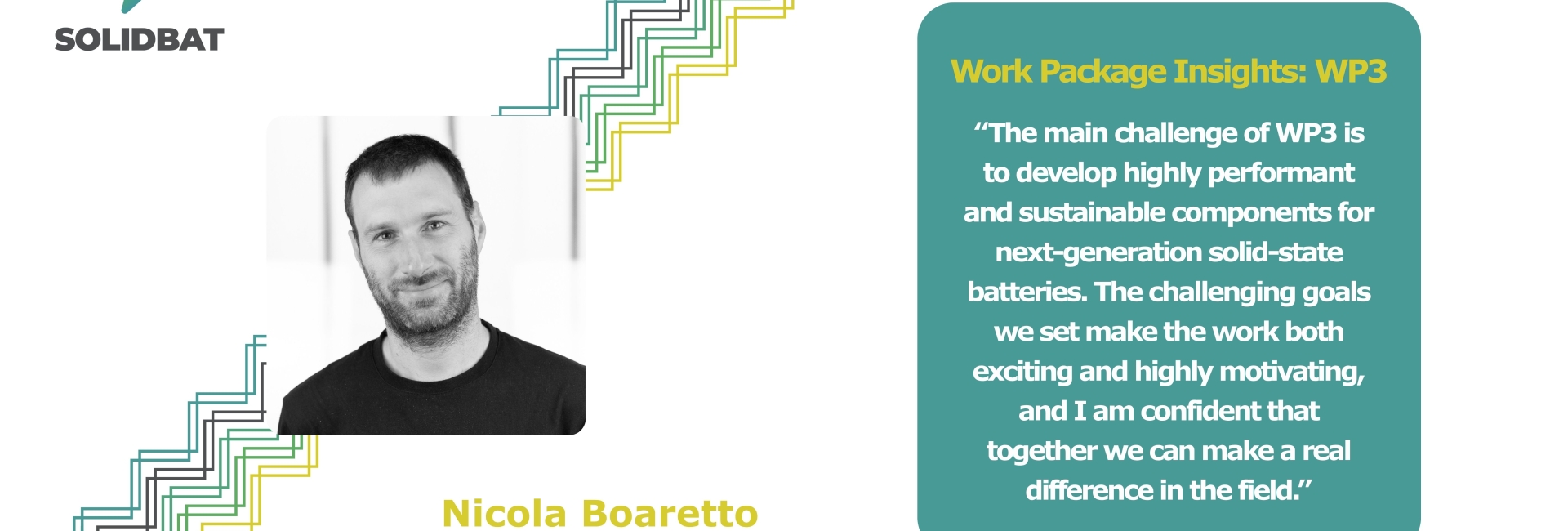
Our work package leaders - Nicola Boaretto
Within the SOLIDBAT project, Nicola Boaretto from CIC energiGUNE leads Work Package 3, dedicated to developing next-generation materials and components for solid-state batteries. His team focuses on creating high-performance, sustainable cathodes, electrolytes, and anodes that can be seamlessly integrated into scalable, industrial-ready cells.


Which are the challenges of your WP(s)?
One of the main challenges of our work package lies in the development of next-generation materials and components—cathode, anode, and electrolyte—that not only match the performance of today’s lithium-ion batteries but also enable higher energy density. At the same time, we are committed to using more sustainable materials and processes, which adds an additional layer of complexity.
For the cathode, achieving high loading and stability while keeping the process water-based is a demanding task. On the electrolyte side, we need to combine mechanical robustness with high ionic conductivity and electrochemical stability—striking the right balance is far from trivial. The use of Li-metal anodes, while critical for boosting energy density, comes with intrinsic challenges related to cyclability and rate capability. Finally, ensuring compatibility among all components is a key hurdle: each may perform well on its own, but integrating them into a robust and durable cell is far more demanding.
All of this has to be achieved in just two years, pushing us to deliver optimized, scalable components ready for upscaling within an ambitious timeframe.
Which achievements do you foresee?
We foresee key breakthroughs in advancing solid-state battery technology. Our work will deliver water-processable NMC811 cathodes with high loading and energy density, paired with a novel gel–polymer electrolyte that combines mechanical robustness, high ionic conductivity, and compatibility with high-voltage materials. On the anode side, we target ultra-thin and 3D-texturized Li-metal electrodes with engineered interfaces to enable long cycle life and fast charge capability. By integrating operando characterization tools and optimizing formation and cycling protocols, we aim to unlock solid-state pouch cells that can reach 500 cycles at 80% depth of discharge—a decisive step toward scalable, safe, and high-performance energy storage
Which synergies do you expect to have with partners?
One of the strengths of this project is the complementarity of expertise: we have partners excelling in every key aspect of solid-state battery development. This creates the opportunity to truly learn from each other and combine knowledge to accelerate progress toward our common goals.
The interaction with WP2 partners, who define requirements and specifications at both material and cell level, is essential to steer our development in the right direction. Equally, the close collaboration with WP4 partners, focused on upscaling, ensures that scalability is embedded into component development from the start. Finally, synergies with WP5 modeling teams will be particularly valuable: while they support us in interpreting experimental results and guiding design choices, we in turn will provide key experimental parameters for model development, enabling a stronger feedback loop between experiments and simulations.
Together, these collaborations form a strong ecosystem, giving us the best chance to reach our ambitious targets.
A personal perspective: what do you like/enjoy/expect from the experience of being a WPL?
It is truly a wonderful experience and a great honor to lead this ambitious work package and to collaborate with such experienced and talented partners. Some of us have already worked together in previous projects, which makes us a close-knit team and gives additional strength to our collaboration. The challenging goals we set make the work both exciting and highly motivating, and I am confident that together we can make a real difference in the field of solid-state batteries.
On a personal level, I look forward not only to seeing the results of our joint efforts but also to learning a great deal along the way—both technically and in terms of organization.